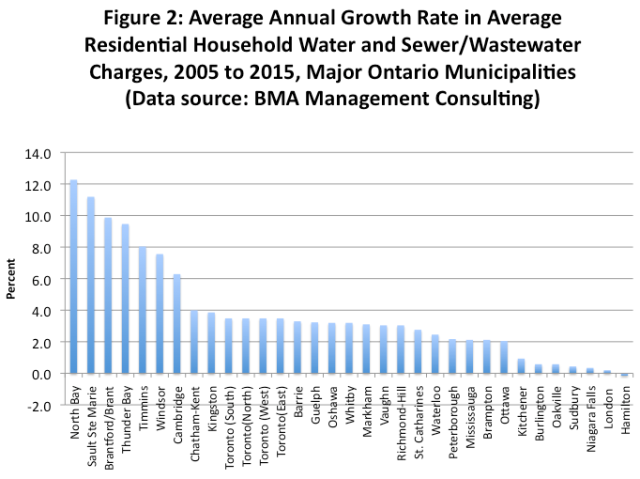The Fraser Institute has released a report on Ontario water rates derived from the BMA Management Consulting Group’s annual municipal studies data, describing the rate changes as rising faster “than residential property taxes since 2005.”
The chart below displays the average cost of household water and wastewater charges in 2015. Rates ranged from $406 in Mississauga and Brampton to $1,224 in Brant. The average cost across the 33 cities in the sample was $800.
The average increase in rate increased by 3.8 per cent from 2005–2015. The largest increases were in North Bay and Sault Ste. Marie, which grew by 12.3 and 11.2 per cent respectively, while Hamilton shrunk its rates by 0.1 per cent.
Of these 33 communities, 4 had slower rate increases than the rise in GDP. Many cities throughout Ontario, and Canada, have seen dramatic growth rates as the municipalities have had to upgrade long neglected water and wastewater infrastructure and, at the same time, account for the introduction of future growth and environmental planning.
Indeed, at the Water in Action 2.0 conference held on October 18th at Toronto’s Yorkville Marriot, representatives from the City of Barrie, the City of London, and York Region discussed how innovative technology, procurement, and policy solutions reduced the expected costs in upgrading and planning for future water infrastructure.
New methods of taxing the service have been implemented, mostly with the addition of fixed rates. According to the Fraser Institute, “in Ottawa, the sewer charge is calculated as a 117 per cent charge on the water usage bill. In Stratford, the sewer rate is about 156 per cent of the water consumption cost. In London, usage charges only comprise about 20 per cent of the bill with the rest being a fixed charge. Indeed, many homeowners find that they are reducing consumption and paying more because of rising fixed charges, thereby eroding the incentive to conserve.”
Water Canada has reported on rate increases across the country, in Calgary and Ottawa.
For more on the Water in Action 2.0 conference, look for Water Canada’s Nov-Dec issue, or visit the conference host, WaterTAP.
The Fraser Institute’s full report can be viewed here.















